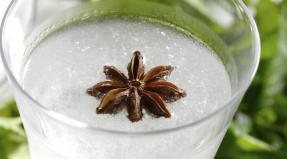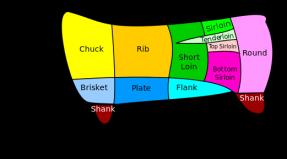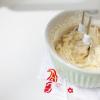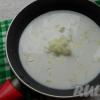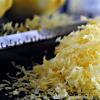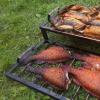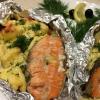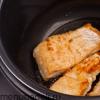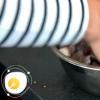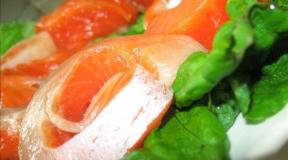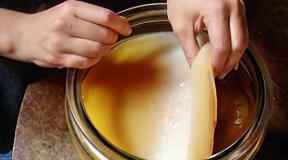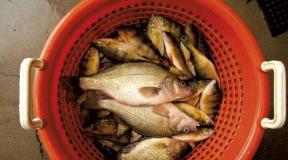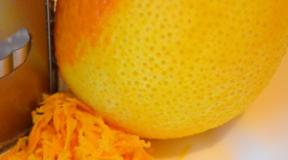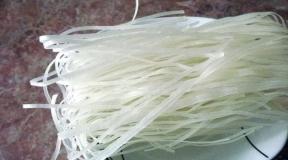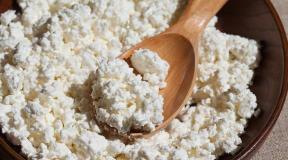Carbohydrates in white and black bread. How many calories in black bread
The calorie content of black bread per 100 grams is 165.2 kcal. 100 g of flour product contains:
- 6.7 g protein;
- 1.2 g fat;
- 34.1 g of carbohydrates.
The product is saturated with vitamins A, B1, B2, B5, B6, B9, E, PP, minerals potassium, calcium, sodium, magnesium, sodium, phosphorus, chlorine, iron, iodine, manganese, copper, molybdenum, fluorine, chromium, zinc.
The calorie content of black bread in 1 piece directly depends on the weight of the piece. An average piece of flour product weighs 35 g. Thus, it contains 57.7 kcal, 2.35 g of protein, 0.42 g of fat, 11.9 g of carbohydrates.
Calorie breadcrumbs from black bread per 100 grams
The calorie content of black bread crackers per 100 grams is 212 kcal. In 100 g of the product 4.8 g of protein, 49.9 g of carbohydrates, 0.6 g of fat.
In one 140-gram serving of such crackers, there are 304 kcal, 8 g of protein, 1 g of fat, 63 g of carbohydrates. To prepare the dish, you will need 140 g of black bread, dry spices and salt to taste.
The bread is cut into long narrow slices, laid out on a baking sheet, seasoned with spices, salted. The oven is heated to the maximum temperature, after which the temperature is set to 60 ° C, the baking sheet with crackers is placed in the oven.
The oven door is left ajar. This will allow excess moisture to come out of the bread. Croutons will be ready in 40-50 minutes.
Calorie black bread with butter per 100 grams
Calorie black bread with butter per 100 grams 300 kcal. In 100 g of the product 5.9 g of protein, 14.7 g of fat, 38.3 g of carbohydrates.
Black bread with butter, when consumed in moderation, is of great benefit to the body. This combination of products is saturated with vitamins A, B, E, D, zinc, potassium, calcium, iron, phosphorus and other minerals.
Calorie croutons of black bread per 100 grams
Calorie croutons of black bread per 100 grams 225 kcal. In 100 g of the dish there are 6 g of protein, 9.4 g of fat, 30.7 g of carbohydrates.
To make croutons, you need the following ingredients:
- 0.2 kg of black bread;
- 2 tablespoons of vegetable oil;
- 3 cloves of garlic;
- 2 g salt.
Bread is cut into small pieces, laid out in a pan with heated vegetable oil. To prevent the croutons from burning and frying on each side, the bread is turned over several times during frying.
Ready croutons are laid out on a plate, salted and mixed with squeezed garlic. The dish is ready!
The benefits of black bread
The benefits of black bread are very great and are as follows:
- the flour product is characterized by a high content of fiber, which contributes to the removal of toxins from the body;
- the rich vitamin and mineral composition of black bread makes it indispensable for beriberi;
- the property of black bread has long been known to increase the concentration of insulin in the blood;
- with regular consumption of the product, effective prevention of breast cancer in women is ensured;
- black bread crackers are indicated for diseases of the stomach, intestines, and a tendency to flatulence. Drying bread completely neutralizes the action of yeast;
- This bread is rich in iron and magnesium.
Harm of black bread
The harm of black bread is manifested by overeating the product and the use of flour products with contraindications. If you love black bread, you should remember that:
it is not as well absorbed by the body as baked goods made from wheat flour. This creates an increased load on the digestive tract;
this product is characterized by high acidity, therefore it is contraindicated in case of stomach ulcers, many intestinal diseases. Nutritionists do not recommend eating more than 160 g of black bread per day;
black bread often provokes heartburn, so it is better to use this product in combination with vegetables, milk, vegetable soups.
Like other flour products, bread is a source of dietary fiber. They are necessary for the normal functioning of the body, including the regulation of peristalsis - the movement of food through the organs of the digestive system. Bread is rich in water-insoluble fiber (cellulose, hemicellulose, lignins). Its presence contributes to a decrease in the energy value of the food consumed and, at the same time, due to the effect of a “full stomach”, fiber provides a feeling of satiety for a long time. This prevents the risk of hunger attacks and reliably protects against overeating.
How many calories are in black bread?
The calorie content of black bread is largely determined by its recipe. 100 grams of grain bread contains 228 kilocalories, the same amount of Darnitsa or Borodino bread contains 200, and black rye bread contains 190 kcal.
Nutritionists do not recommend including bread in your diet for people who are overweight. But there are a huge number of varieties of bread prepared according to various recipes from different types of flour with low and high calorie content. This allows many people not to limit their diet and not deprive themselves of such a valuable and healthy product. If the diet is limited not by the list of foods consumed, but by the number of allowable calories, then all types of bread should be present in the diet in small quantities, including black. After all, they contain a lot of useful and even irreplaceable substances.
 Why do nutritionists dislike bread so much and recommend only some of its types for consumption? The fact is that all the useful substances of grain crops are contained in the shell of the grains. And most often these shells do not fall into the flour. In an effort to improve the taste of bread, people limit themselves to those useful substances that they could get from it. The most delicious and fluffy snow-white bun contains calories and starch in large quantities. And bran and black rye are rightfully considered the most useful and low-calorie bread product.
Why do nutritionists dislike bread so much and recommend only some of its types for consumption? The fact is that all the useful substances of grain crops are contained in the shell of the grains. And most often these shells do not fall into the flour. In an effort to improve the taste of bread, people limit themselves to those useful substances that they could get from it. The most delicious and fluffy snow-white bun contains calories and starch in large quantities. And bran and black rye are rightfully considered the most useful and low-calorie bread product.
Based on these types of bread, special diets and even mono-diets have been developed, which can last from 3 to 10 days. They allow not only to lose extra pounds, but also to improve health, replenish your body with essential amino acids, vitamins and minerals.
Calorie content of various breads per 100 grams
Different types of bread have a certain energy value. Approximate data per 100 g are presented below:

How can bread harm our body?
The reason for this is that many of the nutrients in wheat grains are contained in their shell, which is lost during the grinding process, leaving us basically one starch and a lot of calories.
 The higher the grade of flour from which the bread is baked, the better its taste, but also the less useful substances it will contain, which cannot be said about calories. White bread is only a supplier of calories to our body, and in fact has no benefit.
The higher the grade of flour from which the bread is baked, the better its taste, but also the less useful substances it will contain, which cannot be said about calories. White bread is only a supplier of calories to our body, and in fact has no benefit.
But bran can also be used to make bread, i.e. the grain that remains after grinding. So it is in such bread that the most useful substances will be contained. The most useful bread is deservedly recognized as black and bran. They have the following beneficial properties: They can absorb allergens and toxins, increase the body's immune forces and cleanse the stomach with fiber.
Useful properties of black bread
Black bread contains up to 50% carbohydrates. But these carbohydrates are not dangerous for our figure, since most of them are useful fiber. It helps to cleanse the gastrointestinal tract, the rapid passage of food through the intestines, absorbs toxins and allergens, increases the body's resistance and immunity. Black bread is recommended to be included in your diet at any time of the year, but in winter it is especially useful for those who suffer from anemia and lack of B vitamins.

The composition of black rye bread also includes vitamins A, E, H, PP, choline. Sodium, potassium, chlorine, sulfur, iron, magnesium, copper, fluorine and vanadium are present in large quantities. The amino acids and minerals that make up black bread lower the level of bad cholesterol in the blood, reduce the risk of developing diabetes, coronary heart disease and cancer.
They note the ability of black bread to fight depression and loss of strength, nervous exhaustion and overwork. Caution in the use of this product should be observed in people with high acidity of the stomach and peptic ulcers.
Black bread baked at home from a special sourdough dough is very beneficial for the body. But modern production methods have simplified this process, the magic has disappeared from it, and various components have been added: baking powder, chemical additives that prevent the bread from staling, etc. Therefore, many people prefer to bake brown bread on their own at home with live yeast.
Rye bread - the basis of a delicious drink
For centuries, the technology of making a tasty and healthy drink from rye bread, which perfectly quenches thirst even in the summer heat - kvass, has been tested. This natural drink is easy to prepare at home. There are two main kvass recipes: with and without yeast. Regardless of which method you choose, keep the following points in mind:

To prepare a drink from 0.5 kilograms of black bread, crackers are cut and dried. Then they are mixed with 5 liters of boiling water and a glass of sugar, mixed and the mixture is left to cool. 50 grams of raisins are added to the cooled wort, the container is covered with gauze and placed in a dark place for fermentation. After 4-5 days, the finished drink can be filtered, poured into bottles for storage and cooled. That's all the wisdom of making yeast-free bread kvass.
The effect of bread on health
It is important not only to count how many calories are in a piece of black bread, but also to know about the benefits and harms of bread for the body. Any type of baking is a source of useful trace elements, no matter how many calories there are. For example, rye bread is useful in that it has a positive effect on the intestinal microflora, and white bread in that it has a large amount of B vitamins. White bread will help to cope with pain if the acidity in the stomach is increased.
 But yeast bread is not considered healthy. Yeast in the stomach starts the putrefactive process and interferes with the normal digestion of food. You can use this product no more than once a week.
But yeast bread is not considered healthy. Yeast in the stomach starts the putrefactive process and interferes with the normal digestion of food. You can use this product no more than once a week.
For the manufacture of white bread, very finely ground flour is used, thus many useful components are removed. All that remains is the so-called starchy substance, which, in principle, does not carry anything for the body, it only adds extra calories. Gray bread also belongs to the category of white bread, and its calorie content is almost identical to white bread.
Each of us is individual, so to make the right diet and with questions about giving up bread, you should consult a doctor. It is a qualified specialist who will select you a balanced diet for weight loss or weight gain.
Should I give up bread completely?
Theoretically, the complete exclusion of bread from the diet is possible. However, it should be understood that the body must take from somewhere the vitamins that baked goods contain. Sometimes it's better to reduce the amount of bread and opt for low-calorie options. Several reasons to use this product:
- Eating only 200 grams of bread per day, your body receives the minimum supply of proteins needed by an adult. The calorie content of white bread is higher than that of black bread.
- A snack in the form of a sandwich during an active life is a good alternative to fast food. Make it better with a piece of lean meat and vegetables.
- Bran bread helps the gastrointestinal tract. It cleanses the intestines and promotes weight loss.
Black bread diets
Eating only bread every day and losing extra pounds - this wording sounds somewhat absurd. But in fact, black bread is the basis of effective ways to lose weight. What? Now you will know everything.
Mono-diet, based on the use of black bread in the diet, is designed for a period of 3-5 days. As a result, your weight should decrease by a couple - three kilograms.
The daily diet will include:
- 200 grams of black rye bread;
- 200 ml fruit or vegetable juice. A prerequisite is that the juice must be freshly prepared.
The daily ration should be divided into 4 doses. The intervals between meals should not be less than four hours. Throughout the entire period of following the diet without restrictions, you can drink non-carbonated water and green tea without sugar.
Bread occupies a special place in the traditional diet in our country. Bread is eaten a lot, together with other dishes or separately. Only faced with the need to lose weight, many first think about how many calories are in a slice of bread. Can I eat bread while on a diet? We will try to find an answer to this question in this article.
Nutritional value of different types of bread
On the shelves of our stores you can find many types of bread. Are they all the same in composition and energy value? Of course not.
Rye bread contains 215 kilocalories per 100 grams. This bread is most often recommended during a diet due to its relatively low calorie content. Borodino bread with a diet is also allowed. Its calorie content is 200 kilocalories per 100 grams. Darnitsa bread has a comparable energy value - 210 kilocalories.
White bread of all varieties has a higher calorie content due to the high content of carbohydrates and fats. So, a sliced loaf contains 265 kilocalories per 100 grams, wheat bread - 240 kilocalories. White bread is not always completely excluded from the diet, but it is worth eating only for those who cannot tolerate rye bread for any reason. It's not just about the greater energy value of white bread. Flour of the highest grade in its composition is poor in vitamins and microelements, contains little dietary fiber. White bread with a diet does not give the desired feeling of satiety.
Grain bread is becoming more and more popular in diets. The calorie content of grain bread of different varieties is 220-250 kilocalories. It is made using whole grains of cereals, which makes this type of bread incredibly rich in vitamins and microelements. Whole grains are digested very slowly, so when dieting, such bread helps fight increased appetite and not overeat.
calories in a slice of bread
How many calories in a slice of bread depends on the mass of the product and its variety. A standard piece of bread is considered to be a portion weighing 20-30 grams. This is how much a portion of rye bread weighs in the form of half a piece 1 centimeter thick, cut off from a loaf. The same mass has a piece of white bread 1 centimeter thick, cut off from the middle of the loaf. To determine how many calories are in a piece of bread of one kind or another, divide the calorie content of the product by 4. For example, the calorie content of a sliced loaf is 265 kilocalories per 100 grams. To find out the number of calories in a piece of bread of this variety, we divide 265 by 4. It turns out that a portion of a sliced loaf contains 66 kilocalories. Borodino bread in one piece has an energy value of 50 kilocalories. So the difference is not too big. The main thing, when eating bread with a diet, is not to get too carried away with this product. Even from grain or rye bread, you can easily get better if you eat it without restrictions.
How can bread be eaten on a diet?
 For everyone who is struggling with excess weight or just watching the figure, bread should be significantly limited. It is believed that it is enough to consume about 50 grams of bread per day with a diet. It turns out that you have to limit yourself to only two pieces. It is better if you prefer grain or rye bread during a restrictive diet.
For everyone who is struggling with excess weight or just watching the figure, bread should be significantly limited. It is believed that it is enough to consume about 50 grams of bread per day with a diet. It turns out that you have to limit yourself to only two pieces. It is better if you prefer grain or rye bread during a restrictive diet.
Bread can be eaten with a diet separately from main meals or with soup. You should never eat pasta, porridge, potatoes, rice with bread. Such a meal will be too rich in carbohydrates and calories. Also, eat bread on a diet without butter or vegetable oil. Such an additive will significantly increase the calorie content of a serving.
Sandwiches, of course, are not welcome by any diet for weight loss. Therefore, try to avoid such snacks. Bread can be eaten with a diet both in the morning and in the evening. However, try not to use bread later than 4 hours before bed or after 8 pm.
Bread for weight loss
There are not very many calories in a piece of bread, but when dieting, you have to limit yourself in the amount of this product. Currently, many people are abandoning traditional bread altogether in favor of cereals.
In fact, there are even more calories in bread rolls than in white or black bread. On average, bread rolls have an energy value of about 300 kilocalories. In order for the product to be beneficial, and not extra pounds, you need to limit the consumption of bread to 50 grams per day. Bread for weight loss should be bought from whole grains with the addition of bran. You also need to eat such bread in an amount of up to 50 grams per day. Calories in bread are present due to the presence of a large amount of complex carbohydrates. These substances help a person who is losing weight not to experience constant hunger and maintain good health during a diet.
Do you know that there are about 300 different types of bread today? Naturally, with such a wealth of choice, the buyer is quite spoiled. However, the next time you're shopping for bread, it's worth taking a closer look at the ingredients in order to choose a healthy product. Consider how many calories are in black bread.
What you need to know about the calorie content of black bread?
Brown bread can be classified as a special variety because it is baked mainly from rye flour. It is this cereal that gives the bread its characteristic dark color. From a dietary point of view, rye bread, like its other varieties, contains a large amount of carbohydrates. But at the same time, it also stands out for its high fiber content: almost 8 g per 100 g of the product, which is almost 2 times more than in a traditional white loaf of bread.
How many calories are in a piece of black bread? If we talk about the energy component, then 100 g of rye bread provides about 240 kcal. It is clear that the binding to 100 grams does not mean anything to many, since, probably, no one weighs a portion of bread before eating it. Therefore, let's try to visualize and move on to neatly sliced \u200b\u200bslices of bread on the dinner table, familiar to everyone.
How many calories do you think are in 1 slice of black bread? No need to guess, because such data exists, and we are happy to share this information with you:
- a slice of bread for a sandwich contains 18 kcal;
- a standard medium-sized piece for lunch weighing about 26 g - 67 Kcal;
- bread slice for toast - 31 Kcal;
- a thick piece of bread - 83 kcal.
Many people like rye crackers. How many calories are in brown breadcrumbs? 100 grams of such a product contains about 366 kcal. Thus, one cracker from a standard slice of bread will provide you with as much as 37 kcal of energy.
Rye bread - risk or benefit?

Did you know that the content of rye flour in a recipe for black bread should not be less than 65%? And if it is less, between 10-35%, then such bread, although it is called rye, will no longer be black, but gray. To make black bread, rye flour is constantly mixed with wheat flour. Otherwise, the dough will not rise. This is one of the disadvantages of rye bread, since the low content of white flour is easier to digest for people who are sensitive to gluten.
However, rye bread remains one of the least nutritious among whole grain varieties. And the high fiber content makes it especially attractive for nutrition during weight loss, because vegetable fibers, dissolving in water, form a kind of gel in the intestines, as a result of which we do not feel hungry for a long time.
But that's not all: fiber also slows down the absorption of glucose into the blood, which is why rye bread has a glycemic index of 65, which is considered average. But the lower it is, the less it causes jumps in the increase in insulin, which contributes to the accumulation of fat in the cells of body tissues.
In a word, rye bread is a great alternative to white bread and has many advantages:
- keeps fresh for 3-4 days;
- it is very tasty;
- ideal for breakfast, as a slice of bread along with a glass of orange juice provides a lot of energy, fiber and vitamins;
- black bread contains an amazing combination of iron and B vitamins, which contributes to good digestion;
- the constant use of rye bread will avoid the accumulation of excess weight and obesity.
Product advantages and disadvantages

Rye bread is great for a healthy diet, in particular, it contains:
- phytoestrogens - help prevent breast and colon cancer;
- antioxidants - fight against cell aging and cancer formation;
- vegetable fibers - promote intestinal transit;
- micronutrients such as manganese, calcium, potassium, sodium, help maintain good bone tissue.
Black bread is an ally of those who decide to take care of themselves and bring their weight back to normal:
- it is a source of fiber;
- it has less calories than wheat bread: 240 kcal per 100 g versus 285 kcal;
- it is more nutritious and promotes rapid satiety;
- is the basis for many dishes.
However, despite its advantages, like all food products, rye bread has disadvantages. The fact is that rye, a grain crop used for the production of black bread, is most susceptible to contamination by fungi of the Sporynev family.

- constriction of peripheral vessels, as a result of which the skin becomes cold and gangrene of the extremities may develop;
- nausea;
- headache;
- convulsions;
- paralysis;
- stroke;
- thirst;
- burning sensation on the skin;
- hallucinations.
In the Middle Ages, the mass consumption of bread contaminated with ergot led to epidemics of the so-called Anthony's fire, which destroyed entire villages. Ergot reaches its maximum distribution during very cold winters followed by wet springs and cool summers.
Currently, control is being exercised over the permissible limits for the content of such toxins in crops. To combat ergot, modern pesticides are used, which process the seed. This treatment prevents the spread of ergot mycelium into cereal sprouts. In addition, with the help of selection, varieties that are resistant to infection are developed.
Calorie table
Like other flour products, bread is source of dietary fiber. They are necessary for the normal functioning of the body, including the regulation of peristalsis - the movement of food through the organs of the digestive system.
Bread is rich in water-insoluble fiber (cellulose, hemicellulose, lignins). Its presence helps to reduce the energy value of food consumed and, at the same time, due to the effect of " full stomach» fiber provides a feeling of satiety for a long time. This prevents the risk of hunger attacks and reliably protects against overeating.
Bread bread strife
This should not be forgotten. The number of calories in a loaf of bread depends on its composition. Those who care about the harmony of their own figure, in principle, should take into account. Therefore, you should choose, first of all, bread products, the energy value of which is indicated on the label.  Secondly, it is desirable that the bread be cut into pieces of the same size and thickness. This makes it very easy to control the number of calories consumed.
Secondly, it is desirable that the bread be cut into pieces of the same size and thickness. This makes it very easy to control the number of calories consumed.
Many nutritionists are of the opinion that consumption of bread should be limited in favor of other grain products: flakes, bran, cereals. At the same time, their other colleagues are sure that the recommended 5-6 servings of grain products that each person should consume during the day can completely provide just bread (1 serving - 1 slice or piece).
This is true, you just need to choose whole bread, if possible, the least calorie, which can provide enough nutrients, satisfy hunger and keep a slim figure.
The rate of calorie intake varies depending on gender, age and lifestyle, but in general, children should consume from 1600 to 2200 kcal during the day, adult women - about 1500, men - about 2000 kcal (at rest).
Calories vs. nutritional value
So, let's try to evaluate the popular types of bread in terms of calorie content and the content of useful trace elements. In calculations, we will proceed from the fact that, on average, a piece of sliced bread weighs about 40 gr.

- the black list of high-calorie breads is the first loaf. Calorie content per 100 grams is 238 kcal. Respectively, in one piece as much as 95 kcal. And this is without butter and jam!
- followed by white bread. Any. Its average energy value is 266 kcal per 100 grams or 106 per serving.
But the main drawback of these types of bread lies not in the calorie content, but in their ... uselessness. They are made from white flour, most often wheat. The whiter the flour, the smaller it is, which means that the less useful substances in it, practically did not survive. In fact, white bread contains only gluten and starch.
Dietary fibers are concentrated mainly in the deep layers of grains, so they are much more contained in wholemeal breads. These products include:
 Rye, or black bread. There are 205 calories in 100 grams, or 82 kcal in 40 grams. Despite the fact that one piece of it also gives a rather large amount of calories, they all bring great benefits to the body in addition to the energy itself.
Rye, or black bread. There are 205 calories in 100 grams, or 82 kcal in 40 grams. Despite the fact that one piece of it also gives a rather large amount of calories, they all bring great benefits to the body in addition to the energy itself. In addition, rye flour, in comparison with wheat flour, contains more minerals and vitamins. In particular, black bread is rich in vitamins. group B affecting the work primarily of the nervous and digestive systems.
In addition, the presence of an abundance of vitamins of this group helps to keep hair and skin beautiful and healthy. It also has a lot vitamins A and E indispensable in the fight against aging.
 Recently, grain bread is gaining popularity. And even if he also cannot boast of low calorie content (in one hundred grams - 230 kcal, per serving - 92 kcal). The content of sunflower, melon or flax seeds in it makes it more useful exactly for the usefulness of these same products rich in polyunsaturated fats and omega-6. Eating them with food is extremely important, because our body is not able to synthesize them.
Recently, grain bread is gaining popularity. And even if he also cannot boast of low calorie content (in one hundred grams - 230 kcal, per serving - 92 kcal). The content of sunflower, melon or flax seeds in it makes it more useful exactly for the usefulness of these same products rich in polyunsaturated fats and omega-6. Eating them with food is extremely important, because our body is not able to synthesize them. Black bread - good, white - harm ... or not?
 But, fortunately for lovers of white bread and unfortunately for those who adhere to the "dark side of the force", not everything is so simple.
But, fortunately for lovers of white bread and unfortunately for those who adhere to the "dark side of the force", not everything is so simple. While yeast is used in the manufacture of white bread, black bread is prepared on sour-milk sourdough, which causes its high acidity.
It is undesirable to use black bread for gastritis, ulcers, other diseases of the gastrointestinal tract, as well as for problems with the gallbladder or liver.
In addition, even a healthy stomach is not easy to digest bread baked only from rye flour. Therefore, admixtures of other types of flour are acceptable, including wheat - about 20-30%.
Children's digestive system is much more delicate than that of adults. In addition, they lead a very mobile lifestyle, and their body spends a huge amount of energy on growth. Thus, children especially need easily digestible carbohydrates. It is the high energy value and ease of digestion that make white bread is indispensable in the children's diet.
"Bread" ideas for losing weight
 Even the lowest calorie bread will not help you in the fight against excess weight, if you put a piece of fatty ham with yellow cheese on a thick layer of butter. The best solution here would be light cottage cheese instead of butter and a slice of lean ham or chicken. And add a good portion of vegetables to everything.
Even the lowest calorie bread will not help you in the fight against excess weight, if you put a piece of fatty ham with yellow cheese on a thick layer of butter. The best solution here would be light cottage cheese instead of butter and a slice of lean ham or chicken. And add a good portion of vegetables to everything. Bread croutons (especially good from black bread) diversify any salad and do not increase its calorie content too much.
Don't forget the liquid! In order for dietary fiber to be able to exert its beneficial effect on the body and help it to be satiated, you must consume enough water.
If you are still determined to exclude bread from your diet, then pita bread will be an excellent substitute. Thin cakes, in which you can wrap anything - fried liver to parsley with celery, will please any stomach.
Summing up…
When choosing a particular type of bread, it is worth, first of all, consider your current goals:
- it is urgent to replenish the supply of energy, which is guaranteed to be absorbed by the body - the best choice would be white bread or a loaf.
- feel the lack of unsaturated fats and vitamin B - here is a shelf with cereal breads.
- and if you want to get rid of hunger for a long time by eating less, then black bread made from wholemeal flour is the best option.
